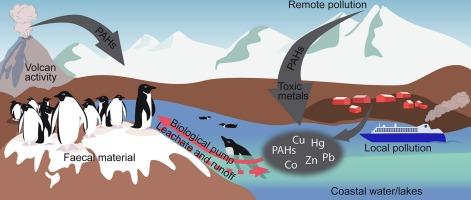南极半岛西北海岸南设得兰群岛企鹅群落土壤中污染物的发生和来源
IF 6.6
1区 农林科学
Q1 SOIL SCIENCE
引用次数: 0
摘要
海鸟被认为是将大量营养物质和污染物从海洋环境转移到陆地的生物泵。本研究评估了南设得兰群岛企鹅群落中潜在有毒痕量金属和多环芳烃(PAHs)的浓度和来源。在利文斯顿和欺骗群岛的四个地点收集了土壤样本和企鹅粪便。土壤有机碳含量低,质地沙质,pH为中性至酸性,电导率低。与对照区(无企鹅)相比,群落土壤中营养物质、微量金属(如P、Zn、Cu)和多环芳烃显著富集,表明企鹅粪便是微量金属的主要来源。多环芳烃有不同的来源:火山活动、生物沉积和轻微的人为影响。欺骗岛上多环芳烃含量的升高与企鹅粪便和过去的火山喷发有关。多环芳烃的浓度没有超过海洋生物的毒性阈值,而一些地点的Cu和Zn含量超过了临界水平,这表明当地地点存在潜在的毒性风险,特别是如果这些金属被浸出到浅水水体中。最终,研究结果表明,企鹅群落在调节南极海岸系统内营养物质和污染物的生物地球化学循环中起着重要的驱动作用。本文章由计算机程序翻译,如有差异,请以英文原文为准。

Occurrence and sources of pollutants in the soils of penguin colonies in the South Shetland Islands, North-West coast of the Antarctic Peninsula
Seabirds are considered to be biological pumps that transfer large quantities of nutrients and pollutants from the marine environment to land. This study assessed the concentrations and sources of potentially toxic trace metals and polycyclic aromatic hydrocarbons (PAHs) in penguin colonies on the South Shetland Islands. Soil samples and penguin droppings were collected from four sites on Livingston and Deception Islands. The soils were characterised by low organic carbon content, sandy texture, neutral to acidic pH and low electrical conductivity. Significant enrichment of nutrients, trace metals (e.g., P, Zn, Cu) and PAHs was observed in colony soils relative to control areas (no penguins), suggesting that penguin droppings are the main source of trace metals. PAHs had different sources: volcanic activity, biological deposition and minor human influence. Elevated levels of PAHs on Deception Island were associated with penguin droppings and past volcanic eruptions. Concentrations of PAHs do not exceed toxicity thresholds for marine organisms, while Cu and Zn contents at some locations sites exceed critical levels, suggesting potential toxicity risks at local sites, especially if these metals are leached into shallow water bodies. Ultimately, the findings establish that penguin colonies act as significant drivers in modulating the biogeochemical cycles of nutrients and contaminants within Antarctic coastal systems.
求助全文
通过发布文献求助,成功后即可免费获取论文全文。
去求助
来源期刊

Geoderma
农林科学-土壤科学
CiteScore
11.80
自引率
6.60%
发文量
597
审稿时长
58 days
期刊介绍:
Geoderma - the global journal of soil science - welcomes authors, readers and soil research from all parts of the world, encourages worldwide soil studies, and embraces all aspects of soil science and its associated pedagogy. The journal particularly welcomes interdisciplinary work focusing on dynamic soil processes and functions across space and time.
 求助内容:
求助内容: 应助结果提醒方式:
应助结果提醒方式:


